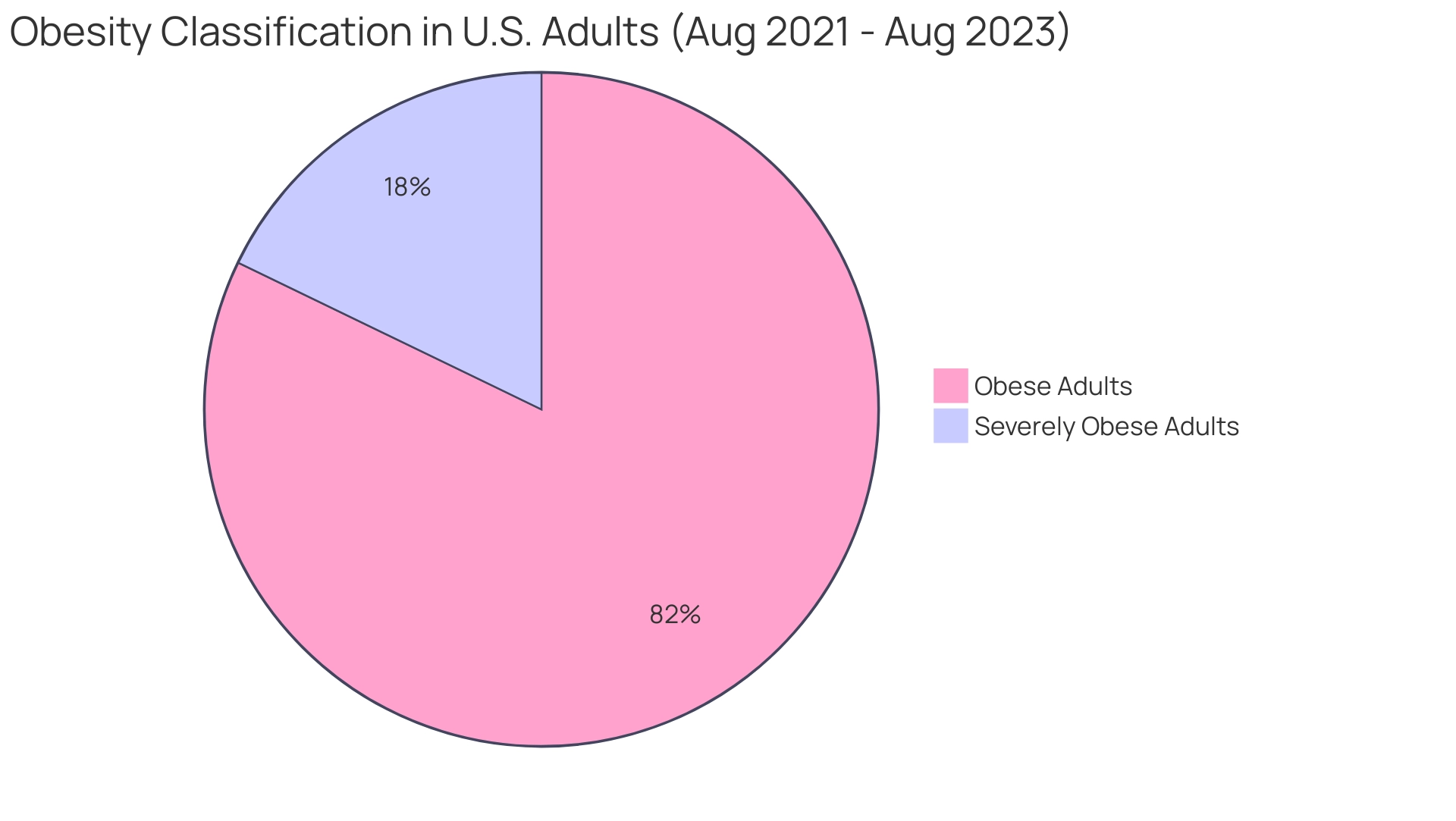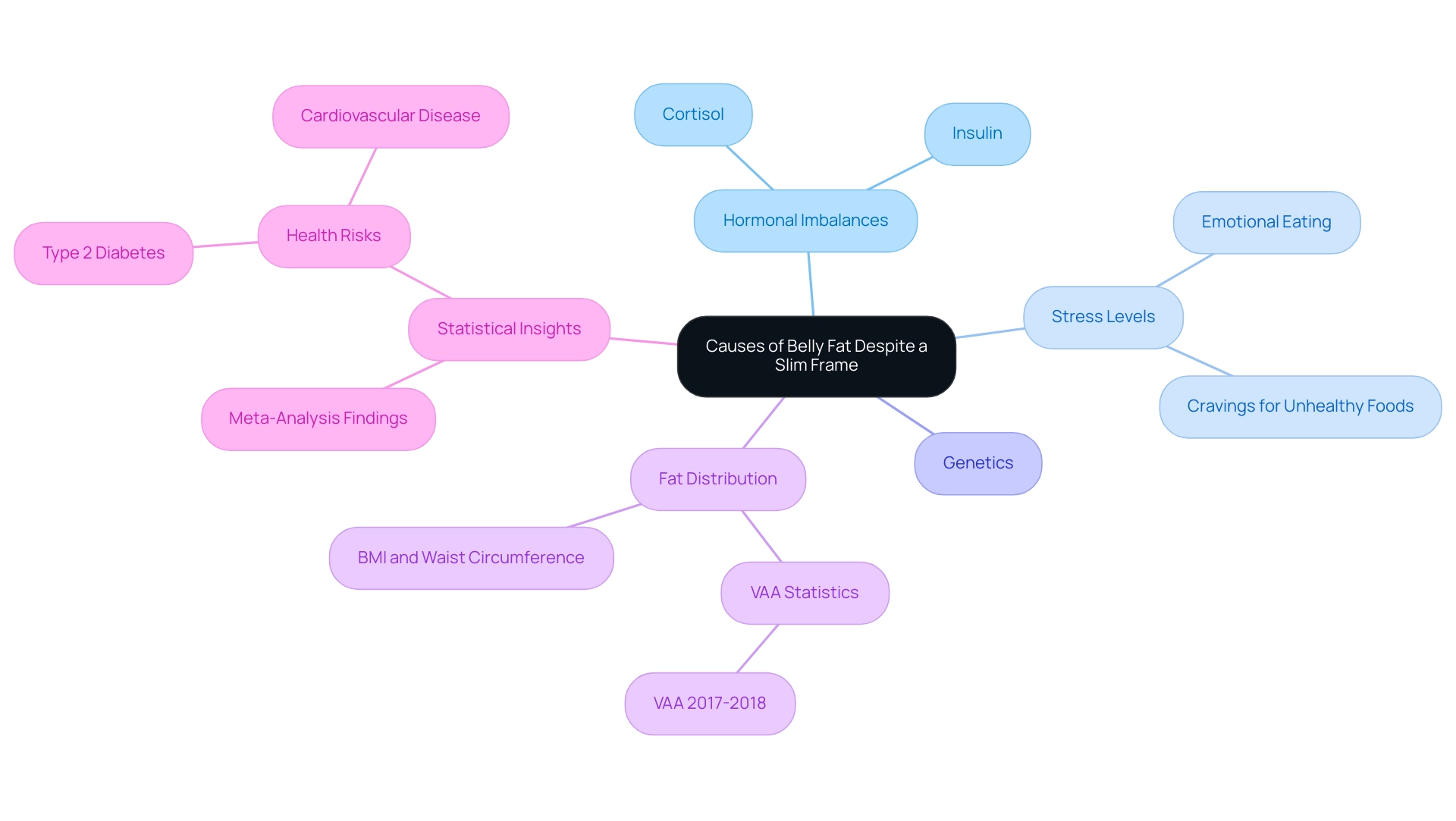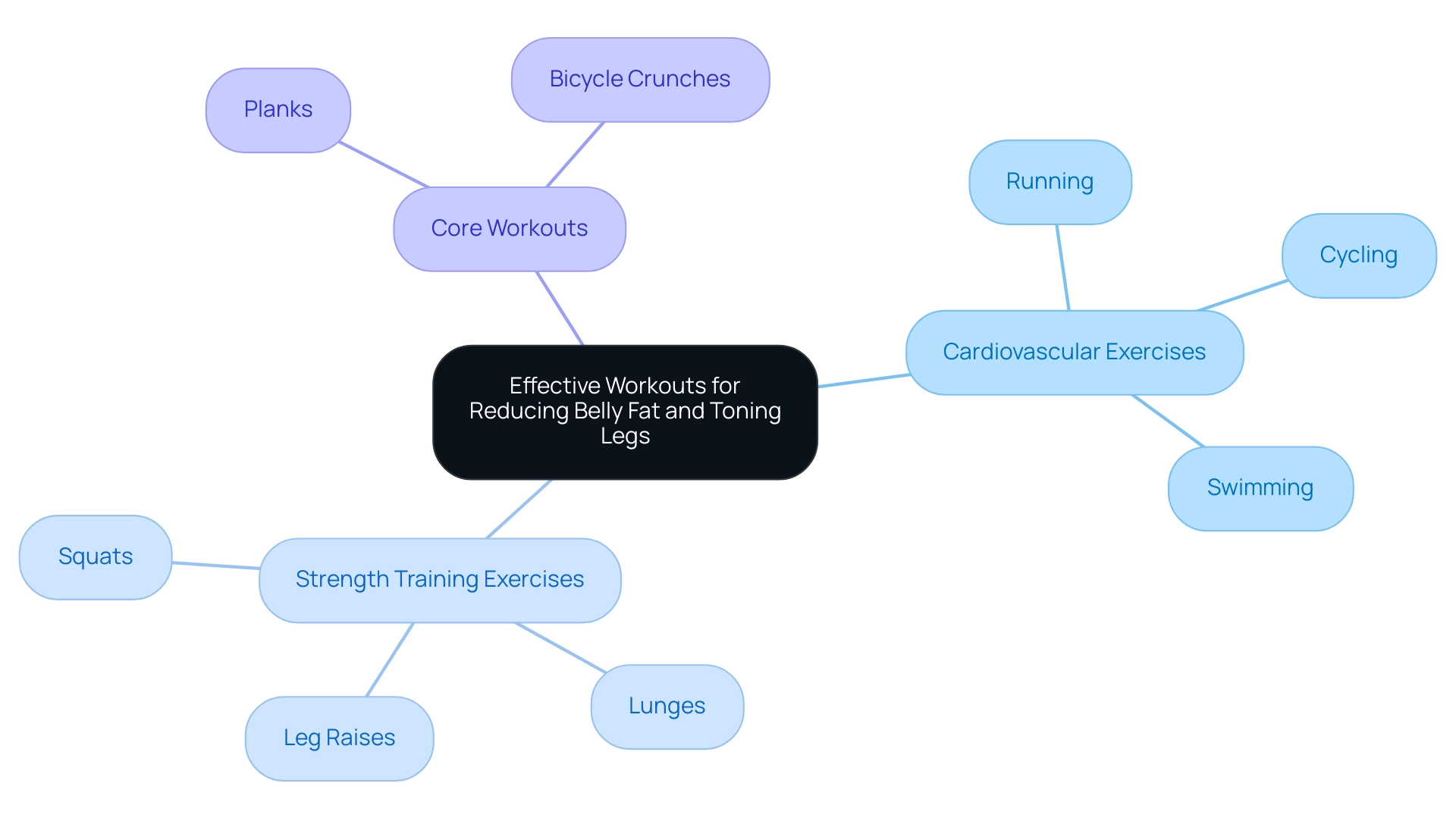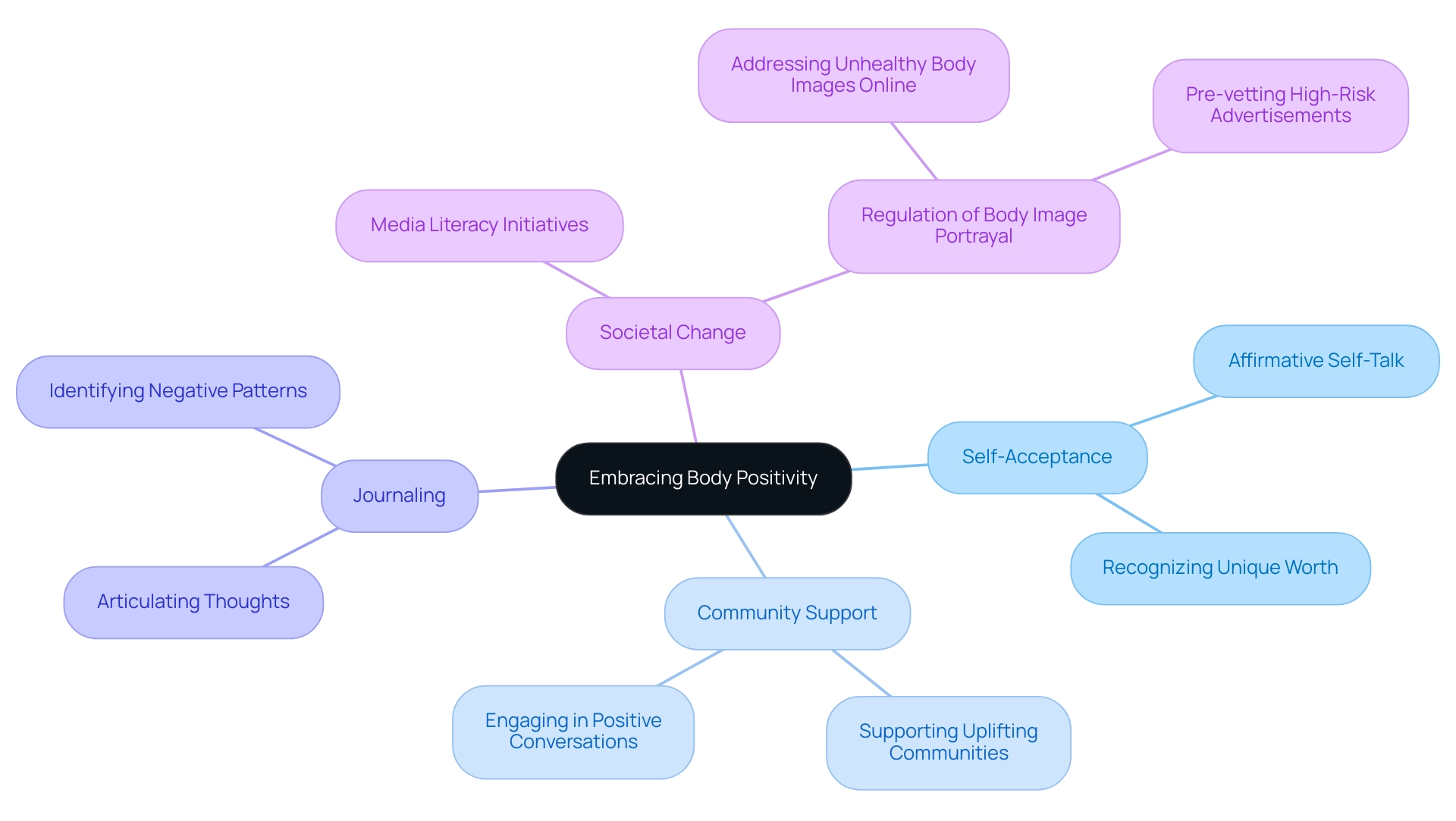Overview
Balancing skinny legs and a big stomach involves understanding the complexities of body composition, including factors like genetics, hormonal imbalances, and lifestyle choices that contribute to this condition. The article emphasizes that adopting a combination of balanced nutrition, effective workouts, and positive lifestyle changes, alongside embracing body positivity, can help individuals achieve a healthier body balance and improve their overall well-being.
Introduction
In a world increasingly obsessed with appearance, the complexities of body composition often go overlooked, particularly the peculiar combination of skinny legs paired with a larger stomach. This phenomenon is more than just a cosmetic concern; it reflects deeper issues tied to genetics, lifestyle, and societal pressures.
With alarming statistics revealing that over 42% of U.S. adults are classified as obese, understanding the factors contributing to such disparities is crucial. From hormonal imbalances to the impact of media portrayals of ideal body types, the conversation surrounding body image is multifaceted and deeply personal.
As individuals navigate their health journeys, recognizing the unique composition of their bodies can empower them to set realistic goals and pursue balanced health strategies. This article delves into the underlying causes of body composition disparities, explores effective nutritional and workout strategies, and emphasizes the importance of embracing body positivity in a society fixated on unrealistic standards.
Understanding Body Composition: Skinny Legs and a Big Stomach
Body composition is a crucial metric that indicates the ratio of fat to non-fat mass within an individual, significantly affecting overall health. Recent studies highlight disparities in shape, particularly the phenomenon of skinny legs big stomach. This condition can arise from a complex interplay of factors, including genetics, lifestyle choices, and dietary habits.
According to data from the National Health and Nutrition Examination Survey (NHANES) covering August 2021 to August 2023, approximately 42.4% of adults in the U.S. are classified as obese, and 9.2% as severely obese, illustrating a concerning trend in composition disparities across diverse populations. Dr. Jake Linardon, a notable expert in the field, states,
This sounds like a very complex and stressful situation
underscoring the multifaceted nature of image issues. Moreover, the media's promotion of unrealistic physical ideals significantly contributes to dissatisfaction with one's appearance, as evidenced by the case study titled 'Media Influence on Body Image,' which reveals that many young girls aspire to the shapes portrayed in fashion magazines, leading to unhealthy weight control behaviors.
Recognizing that physique is not solely influenced by personal choices but also affected by genetics and environmental factors is essential in establishing realistic expectations for wellness objectives. Significantly, specialists Cheryl D. Fryar, Bryan Stierman, and Cynthia L. Ogden from the National Center for Health Statistics highlight the importance of acknowledging the unique makeup of each person, which can enable individuals to adopt balanced wellness strategies, ultimately improving their well-being.

What Causes Belly Fat Despite a Slim Frame?
The accumulation of belly fat in individuals who have skinny legs and a big stomach is influenced by various intertwined factors. Hormonal imbalances, especially those related to cortisol and insulin, are significant contributors to this phenomenon. As noted by health expert Jennifer Kuk,
BMI is an independent and positive correlate of VAT in adults before adjustment for waist circumference; however, BMI is negatively associated with VAT mass after adjustment for waist circumference.
This indicates that traditional measures may not fully capture the complexities of fat distribution. High-stress levels also play a crucial role, often leading to emotional eating and increased cravings for unhealthy foods, which can exacerbate abdominal fat accumulation, contributing to skinny legs and a big stomach. Genetics further complicates the landscape, influencing how and where fat is stored within the organism.
Understanding these underlying causes is essential for developing an effective action plan to manage the issues related to skinny legs and big stomach. Furthermore, the VAA statistic for 2017–2018 was 104.64 (99.52–109.76), highlighting the prevalence of abdominal fat in populations. Current research emphasizes the necessity of measuring waist circumference and mass index (BMI) during clinical encounters to identify at-risk individuals, given the rise in obesity and its associated comorbidities such as type 2 diabetes and cardiovascular disease.
Additionally, a statistical analysis and meta-analysis methodology case study revealed insights into the relationship between central obesity measures and mortality, emphasizing the importance of understanding fat distribution in managing health outcomes.

Nutritional Strategies to Combat Belly Fat
To effectively combat belly fat, adopting a balanced diet that prioritizes whole foods is essential. This includes a variety of fruits, vegetables, lean proteins, and whole grains, which are essential for promoting fat loss while preserving lean body mass. Reducing the intake of refined sugars and saturated fats is vital, as these elements are known contributors to fat accumulation.
As noted by Franziska Spritzler, 'A 6-year study found that monkeys who ate a high trans fat diet gained 33% more abdominal fat than those eating a diet high in monounsaturated fat,' highlighting the importance of dietary choices. Including fiber-rich foods can greatly improve digestion and support a healthy body composition; as mentioned by nutrition experts, diets high in fiber are associated with better management outcomes. Additionally, a meta-analysis found that participants following very-low-calorie diets (VLCDs), which provide 800 kcal/day or less, lost and maintained more weight compared to those on balanced hypocaloric diets, underscoring the effectiveness of focused nutritional strategies.
Furthermore, a case study titled 'Dietary Changes for Belly Fat Loss' emphasizes that a diet centered around minimally-processed foods is essential for effective fat loss. Staying adequately hydrated and limiting alcohol consumption can further support overall well-being and facilitate fat management. For tailored dietary recommendations that best suit your specific needs, consulting a nutritionist can provide valuable insights.
By adopting these nutritional strategies, individuals can strive towards successfully reducing belly fat and attaining their wellness goals.
![]()
Effective Workouts for Reducing Belly Fat and Toning Legs
To effectively tackle belly fat and tone your legs, especially for males over 30 classified as overweight with a BMI of 25 kg/m² or higher, incorporating a blend of cardiovascular and strength training exercises is essential to prevent having skinny legs big stomach. Engaging in activities such as:
- Running
- Cycling
- Swimming
promotes calorie burning, while strength training exercises like:
- Squats
- Lunges
- Leg raises
specifically target leg muscles for enhanced definition. Core workouts, including:
- Planks
- Bicycle crunches
play a critical role in strengthening abdominal muscles, crucial for overall fitness.
Aiming for at least 150 minutes of moderate aerobic activity weekly, coupled with two days dedicated to strength training, is recommended for optimal results. Consistency remains a vital factor in achieving and maintaining desired outcomes. Recent studies emphasize the necessity for additional investigation into how different elements, including training intensity and personal traits, influence exercise effectiveness on body composition and metabolic well-being.
As James T. Patrie noted, discussions around statistical considerations in fitness research can lead to a more nuanced understanding of effective workout strategies. Additionally, a study titled "The Metabolic Costs 30 Years After Preterm Birth" illustrates the long-term health challenges associated with metabolic health, emphasizing the importance of effective workouts in reducing belly fat, particularly for individuals with skinny legs and a big stomach, and promoting overall fitness.

Lifestyle Changes for a Healthier Body Balance
Embracing a healthier lifestyle extends beyond mere dietary adjustments and physical activity. Crucially, prioritizing good sleep hygiene is essential, with experts recommending 7-9 hours of quality sleep each night. Studies consistently indicate that insufficient sleep is associated with a body type often described as having skinny legs big stomach, especially the buildup of abdominal fat.
A review examining the role of sleep deprivation in managing body mass highlights its implications for obesity treatment, especially for those struggling with skinny legs and a big stomach, underscoring the critical nature of sleep in maintaining a healthy physique. Engaging in regular exercise—at least 150 minutes of moderate-intensity or 75 minutes of high-intensity weekly—can significantly enhance daytime concentration and mitigate sleepiness, further supporting effective weight management. Additionally, implementing stress-reduction techniques such as mindfulness, meditation, or yoga can help manage cortisol levels, which are often elevated during stressful periods.
These lifestyle changes not only enhance mental wellness but also cultivate a supportive social network, improving overall well-being. As RMS notes, "Family member holds Novo Nordisk stock," emphasizing the financial implications of wellness management. Furthermore, a case study titled 'Sleep Deprivation and Food Choices' reveals that sleep-deprived individuals tend to gravitate towards unhealthy food options due to diminished energy for meal preparation and reduced willpower against cravings.
By making small, sustainable lifestyle changes, individuals can achieve significant improvements in their equilibrium and health over time. Recent statistics indicate that improving sleep hygiene can lead to a 20% reduction in the likelihood of weight gain, further emphasizing the importance of these lifestyle changes.

Embracing Body Positivity: Accepting Your Unique Shape
Embracing positivity towards oneself involves recognizing and appreciating your figure in its unique form, independent of societal standards. It's essential to understand that your worth is not dictated by your appearance. Cultivating a positive self-image starts with engaging in affirmative self-talk and surrounding yourself with a community that supports and uplifts you.
Journaling can be a powerful tool in this process, allowing you to articulate your thoughts and feelings regarding physical appearance, thereby identifying and challenging negative patterns. As you navigate your health journey, celebrate every step forward, no matter how small. By fostering a mindset of self-acceptance, you not only contribute to your well-being but also join a movement toward creating spaces that celebrate diversity and individuality.
As noted, "By creating spaces that celebrate diversity and individuality, society can move toward a future where women feel valued and accepted, free from the constraints of unrealistic beauty ideals." Furthermore, educational initiatives that build media literacy and self-compassion are essential in empowering individuals to engage healthily with image messages. Additionally, the regulation of body image portrayal, as highlighted in a recent case study, calls for addressing the promotion of unhealthy body images online, ultimately shaping a society where everyone feels valued and accepted.

Conclusion
Understanding body composition and its disparities is crucial in a world fixated on appearance. The phenomenon of having skinny legs paired with a larger stomach reveals the complex interplay of genetic, hormonal, and lifestyle factors that contribute to body shape. The alarming statistics on obesity underscore the importance of recognizing these complexities, as individuals grapple with health goals in a society influenced by unrealistic body ideals.
Effective nutritional strategies and tailored workout plans are vital in addressing belly fat while promoting overall health. Emphasizing whole foods, regular exercise, and stress management not only aids in achieving personal health goals but also fosters a balanced lifestyle. Moreover, prioritizing good sleep hygiene can significantly impact weight management and overall well-being, proving that holistic approaches are necessary for sustainable health.
Ultimately, embracing body positivity is essential in this journey. Recognizing and accepting one's unique shape, independent of societal pressures, cultivates a healthier self-image and promotes well-being. By fostering a supportive community and engaging in self-affirmative practices, individuals can contribute to a broader movement that values diversity and individuality. This shift not only empowers personal health journeys but also paves the way for a society that celebrates all body types, free from the constraints of unrealistic beauty standards.




